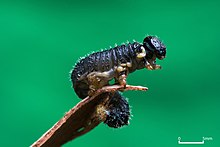Pergidae
| Pergidae | |
|---|---|
 |
|
| Perga sp. larva | |
 |
|
| Melaleuca sawfly, Lophyrotoma zonalis | |
| Scientific classification | |
| Kingdom: | Animalia |
| Phylum: | Arthropoda |
| Class: | Insecta |
| Order: | Hymenoptera |
| Suborder: | Symphyta |
| Superfamily: | Tenthredinoidea |
| Family: | Pergidae |
The Pergidae are a moderate-sized family of sawflies occurring in the Western Hemisphere and the Australasian Region. The Pergidae are, with almost 450 described species, the third-largest family of Symphyta after the Tenthredinidae and the Argidae. Morphologically, most pergids are typically sawfly-like, but the form of the antennae varies considerably in number of segments and from simple to serrate and pectinate or even bipectinate. Sexual dimorphism is common and reflected in differences in type of antennae, colour, and size. Included are some of the few known apterous sawflies, those of the genus Cladomacra occurring in Papua New Guinea and Indonesia, and a species with brachypterous females, Clarissa tasbates, in Tasmania.
The majority of Pergidae species occur in South America and Australia. They are the dominant family in Australia and are one of the major families in the Neotropics. Of the 14 subfamilies, three, Pergulinae, Philomastiginae, and Perreyiinae, are common to both the Australasian and Neotropical regions, but no genera occur in both regions.
In the Australasian Region, Pergidae occur in Australia (including Tasmania) and the islands of New Guinea and New Britain. The most northeastern records are Sulawesi and Indonesia with two species of Cladomacra described from Sulawesi. Only one introduced species (Phylacteophaga froggatti) occurs in New Zealand and New Caledonia, but none is native to those countries. In the Western Hemisphere, they occur from southeastern Canada through the eastern United States south to the southern tip of South America (Magallanes Province, Chile), with their greatest diversity in the Neotropics. In the West Indies, only several species of the genus Acordulecera are known from Montserrat, St. Kitts, St. Vincent, and Dominica. Only one genus, Acordulecera, with several species, occurs in Canada and the United States.
Biology and food plant data are still lacking for most pergid species. Food plants are extremely diverse and those for the Australasian fauna are much better known than for the Neotropics. Though many of the Australian species feed on various species of Eucalyptus (sensu lato), others have such divergent food plants as dead or dying leaves, aquatic ferns, and fungi. Most are external leaf feeders, though some are shoot borers or leaf miners. Some Euryinae are saprophagous, live on or close to the ground, and are crepuscular or nocturnal. Adult habits are known for few, but maternal care is known in some Australian species of the subfamilies Perginae and Philomastiginae and the South American Syzygoniinae.
...
Wikipedia
